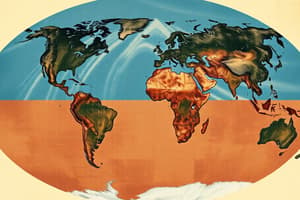Podcast
Questions and Answers
قم بمطابقة العملية التي ساهمت في تشكيل قارة واحدة عملاقة تُعرف باسم بانغيا:
قم بمطابقة العملية التي ساهمت في تشكيل قارة واحدة عملاقة تُعرف باسم بانغيا:
الانفصال القاري = تحرك قواعد البحار النشاط البركاني = تشكل الجبال حركة صفائح التكتونية = تشكل القارات تحرك طبقات قاع البحار = تشكل الفوارق الجيولوجية
قم بمطابقة التطورات التي شهدتها قشور الأرض على مر الزمن:
قم بمطابقة التطورات التي شهدتها قشور الأرض على مر الزمن:
عصور جليدية متعددة = تشكيل سلاسل جبلية دورات للقارات العظمى = تشكيل حفر واديه أحداث تكتونية = تشكيل محيطات حركة البر والبحر = تشكيل خصائص القارات
قم بمطابقة التغيرات التي شهدتها القارات على مر التاريخ:
قم بمطابقة التغيرات التي شهدتها القارات على مر التاريخ:
تشكيل أراضٍ جديدة = انفصال قارات عن بعضها تشكيل سلاسل جبلية = الانجذاب الجيولوجي ظهور بحيرات جديدة = تغير أنواع المناخ حركة صفائح التكتونية = ارتفاع مستوى سطح البحر
قم بمطابقة التأثيرات التي تسببت في تفريق الأراضي والبحار:
قم بمطابقة التأثيرات التي تسببت في تفريق الأراضي والبحار:
قم بمطابقة العمليات التي شهدها تشكيل الجبال والوديان على مر التاريخ:
قم بمطابقة العمليات التي شهدها تشكيل الجبال والوديان على مر التاريخ:
قم بربط كل فترة زمنية بالتأثير الذي حدث خلالها على القارات:
قم بربط كل فترة زمنية بالتأثير الذي حدث خلالها على القارات:
قم بمطابقة نوع التأثير بالعامل المسؤول عنه على قارات الأرض:
قم بمطابقة نوع التأثير بالعامل المسؤول عنه على قارات الأرض:
قم بربط كل نشاط بالآثار التي يسببها على قارات الأرض:
قم بربط كل نشاط بالآثار التي يسببها على قارات الأرض:
قم بمطابقة كل نشاط بالمشكلات التى يُسبِّبُهَا على سطح قارات الأَرْض:
قم بمطابقة كل نشاط بالمشكلات التى يُسبِّبُهَا على سطح قارات الأَرْض:
قُم بــــــــــــــــــإِخْتِیَآآآآآآآآآآآآآآآآآآآآآایِیر كُلا من هذہ المصطلاحہ مع تأثیرهَہ على ھیکَہ سُطُح قارّۃ ٱلاَّ رّض:
قُم بــــــــــــــــــإِخْتِیَآآآآآآآآآآآآآآآآآآآآآایِیر كُلا من هذہ المصطلاحہ مع تأثیرهَہ على ھیکَہ سُطُح قارّۃ ٱلاَّ رّض:
Flashcards are hidden until you start studying
Study Notes
The Beginning of Continent Earth: Then and Now
Earth's continents are grand, ancient structures that have evolved over billions of years, a tale that stretches back to the primordial ooze. Here, we'll dive into the fascinating history of our planet's continents, from the earliest epochs to the present day and beyond.
Formation: The Breakup of Pangaea
Approximately 200 million years ago, our planet was home to a single gigantic supercontinent known as Pangaea. This massive landmass began to fracture and drift apart, gradually giving rise to the continents we recognize today. This process, called continental drift, was driven primarily by plate tectonics and was aided by volcanic activity, mountain building, and the movement of seafloors.
Evolution: The Movement of Land and Seas
Over the next billions of years, Earth's continents continued to move and interact, forming oceans and land masses, mountain ranges, and valleys. A series of ice ages, supercontinent cycles, and tectonic events further shaped our planet's continents and their distinct features.
Continental Changes Throughout History
Earth's continents have undergone significant changes throughout history, leading to the formation of new landmasses and the separation of others. Some examples highlighting the dynamic nature of continents include:
- Cretaceous Period (145-66 million years ago): During this period, the supercontinent Gondwana began to break apart, eventually forming South America, Africa, Antarctica, Australia, and the Indian subcontinent.
- Eocene Epoch (56-34 million years ago): The Tethys Ocean, which once stretched from the Mediterranean to the Indian Ocean, began to close, ultimately creating the Himalayan mountain range and forming Asia.
- Ice Age Cycles: Glacial periods have repeatedly altered the landscape and distribution of Earth's continents, influencing the formation of valleys, coastal plains, and climate zones.
The Present and Future of Earth's Continents
Today, Earth's continents are largely stable, but they are by no means an unchanging landscape. Climate change, plate tectonics, and human activity continue to shape our planet's continents.
- Climate Change: Rising sea levels threaten to submerge low-lying coastal areas, while alterations in precipitation patterns could lead to the expansion or contraction of deserts.
- Plate Tectonics: The movement of Earth's tectonic plates will continue to shape and reshape our planet's continents, leading to the formation of new landmasses and the breakup of existing ones.
- Human Activity: Industrialization, deforestation, and urbanization have significantly impacted Earth's continents, causing issues such as pollution, habitat loss, and climate change.
The story of Earth's continents is one of evolution, adaptation, and change—a tale that continues to unfold as our planet navigates the challenges of the present and the unknowns of the future. Whether it's the eruption of a volcano, the rise of a new mountain range, or the appearance of a new island, Earth's continents are always in motion, and their history is rich with wonder and mystery.
Studying That Suits You
Use AI to generate personalized quizzes and flashcards to suit your learning preferences.




